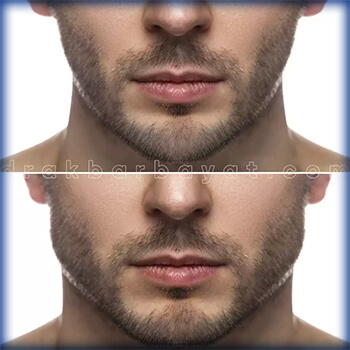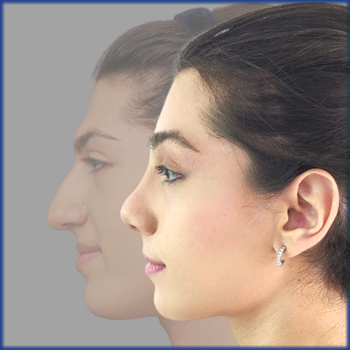-
What is microlipoinjection?
Microlipoinjection or autologous fat transfer is a common technique used in cosmetic surgery. It is actually a form of tissue transplant in which live lipid cells are taken from the body and transferred to another part of the body before these cells die. It can be easily done without anesthesia and, unlike liposuction which has such side effects as fat embolism, fat transfer is largely safe and free of these side effects since the amount of fat transferred is very small.
Techniques
In fat transfer, delicate cannulae are used to take fat from a part of body through a very small opening that will not require stitches after the operation. The fat initially contains some blood and serum. Therefore, different techniques are used to remove these substances and obtain a more pure fat. Finally, this fat is injected to different parts of the face using needles and cannulae particularly designed for this purpose.
Applications
Fat is injected to shape different parts of the face (for example, lip or cheek augmentation) or to remove wrinkles. In this regard, fat transfer works like filler injection. It can remove many signs of aging. The technique is particularly recommended for people under 60 who are willing to perform facelift and often postpone it for several reasons. In case of removing superficial wrinkles and removing blemish traces, fat is usually injected superficially to obtain the best effects. In this case, the fat stimulates the process of subcutaneous collagen production and gives the skin a younger look. In cases where fat transfer is used to remove deep wrinkles or to augment lips, cheeks, or other parts of the face, the injection area is more extensive and goes deep down the skin.
How long will effects of fat transfer last?
Contrary to the popular believe, fat transfer has permanent effects. The success largely depends on the doctor’s skills. Short-lasting effects are often the result of miscalculations in terms of the amount of fat or the technique used in the process. In other words, this is caused by insufficient number of fat cells or presence of dead cells. For example, an improper technique is to take a large amount of fat, use some of this fat for initial injection, and then freeze the remaining fat for later use. Clearly, no live cell will be injected in the next process, and the effects will not last long.
Required re-injections
If a large amount of fat is needed for shaping or rejuvenating the face, re-injection may be needed to get a better result. The results will depend on the surgeon’s skills in addition to the individual’s conditions and post-injection cares. Re-injections are more frequent for people who smoke or those with chronic diseases like diabetes, hypertension, blood clotting issues, and the like. It should be noted that the injected fat acts like fats in other parts of the body; that is, if the individual loses too much weight after the surgery, the injected fat will be absorbed, calling for reinjection. So, if you want to lose weight, do this before fat transfer.
Important advantages of fat transfer over fillers
Infections are quite unlikely in fat transfer compared to filler injection. Therefore, people with a higher risk of infection, like those with prosthetic chin or cheek, should use fat transfer instead of fillers.
In sum, fat transfer is much cheaper than filler injection since most high-quality fillers which are free of side effects are expensive, have transient effects, and need reinjection. Bumps are unlikely at fat injection spots while they are commonly observed in filler injection and may last for a long time. This is usually the case for injections into lips and under the eyes.
Collagen production is stimulated by superficial and subcutaneous fat transfer, giving your face a younger look while filler injection has no particular effect on the skin. So, ask for fat transfer if you want to have a rejuvenated skin with fewer wrinkles.
The injected fat does not move, but fillers, particularly those with longer-lasting effects, do.
Disadvantages of fat transfer compared to fillers
Filler’s effects immediately appear. Filler injection creates fewer bruises and bloating but the results of fat transfer appear after several weeks. So if you are planning to go to a social event like a wedding, do not ask for fat transfer and leave it for some other time.
In fat transfer, the fat should be first removed from another part of the body and this may cause bruises or swelling at those parts but this is not the case for filler injection (some people want the fat to be removed from the hips or abdominal area since this make them look smaller).
Fat transfer needs a longer time compared to filler injection, and thin individuals who do not have sufficient fat are left with no option but filler injection.
Post-surgery cares
Since post-surgery cares are just as important as the surgery, you should note the following:
- You may feel bruises, swelling, or irritation at fat removal or injection spots. This feeling quite normal and should go away within several days or weeks. You may also feel pressure or a sense of stretch in your face. This will also go away within one or two weeks.
- To reduce swelling, use cold compress for the three days following the surgery. Do this for two days at spots where you feel irritation. You can use cold compress for a longer time if the swelling does not go away.
- For the first two nights following the surgery, sleep half-seated. This will help reduce post-surgery swelling. Do this for a week if you are comfortable sleeping in this position.
- You will notice swelling by three days after the surgery. You shouldn’t worry as this is quite normal and the swelling will disappear gradually.
- You may feel that the swelling at one side of the face is larger than the other side. Don’t worry. Swelling is not the same at both sides and this condition may last for several weeks.
- To reduce swelling, eat low-salt meals (especially at nights).
- During the post-surgery recovery avoid activities that need bending (like sweeping or vacuum cleaning) or pressure (like weight lifting) since this may cause longer swelling.
- Rigorous exercise is forbidden for the first week. Start with low-pressure activities and gradually increase the level of your activity. Reduce your activity if you notice increased swelling.
- There is no limitation for activities that involved the spots where fat has been removed. However, pressure on abdominal area may lead to swelling.
- If you underwent only fat transfer there will be no stitches to remove (if you underwent facelift as well, stitches should be removed after one week).
- You may use cosmetics after one day. But do not massage your face and do not exert too much pressure.
- You may notice changes even one year after the surgery. This does not mean that the fat is gone. However, normally swelling may be observed up to 6 months after the surgery.
Side effects
Proper fat transfer does not involve dangerous, life-threatening risk like fat embolism or death. The followings are important side effects of fat transfer:
Swelling:
The most important side effect of fat transfer is swelling at spots where fat has been removed or injected. This swelling, for the most part, will disappear within some weeks.
Bruises:
Bruises are also felt at spots where fat has been removed or injected. They are often gone within one week.
Numbness:
This is not a major problem for most patients and is often gone without any intervention.
Asymmetry:
This will be gone once the swelling disappear.
Short-lasting effects of fat transfer:
The amount of fat transferred depends on the technique and medical history. Your doctor should take care of this by calculating the right amount of fat required for the transfer.
زمان مطالعه مطلب: 5 دقیقه


